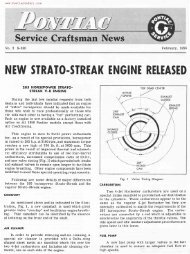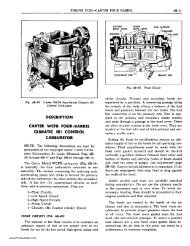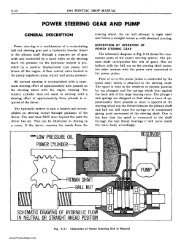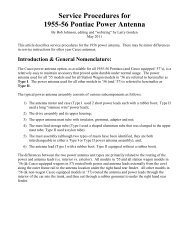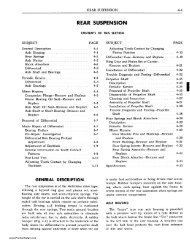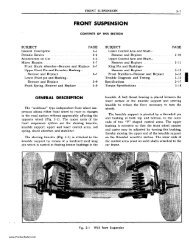Contents / General Description / Carter WGD 2
Contents / General Description / Carter WGD 2
Contents / General Description / Carter WGD 2
You also want an ePaper? Increase the reach of your titles
YUMPU automatically turns print PDFs into web optimized ePapers that Google loves.
68-18 1955 PONTIAC SHOP MANUAL<br />
TO COMPLETE ASSEMBLY OF AIR HORN<br />
1. Install choke baffle plate and gasket as shown in<br />
Fig.6B-38.<br />
2. Install thermostatic coil and housing assembly<br />
to air hom with index mark on plastic housing positioned<br />
at the bottom. Revolve housing in direction<br />
opposite to arrow until index mark on thermostatic<br />
coil housing assembly is one notch past center index<br />
mark on piston housing. Tighten attaching screws<br />
securely.<br />
TEST BEFORE INSTALLATION ON ENGINE<br />
It is good shop practice to fill the carburetor bowl<br />
before installing the carburetor. This reduces the<br />
strain on the starting motor and battery and reduces<br />
the possibility of backfiring while attempting to start<br />
the engine. A fuel pump clamped on the bench, a<br />
l!,mall supply of fuel and the necessary fittings enable<br />
the carburetor to be plIed and the operation of the<br />
float and intake needle and seat to be checked. Operate<br />
the throttle several times and check the discharge<br />
from the pump jets before installing the<br />
carburetor.<br />
TROUBLE DIAGNOSIS AND<br />
TESTING-CARTER<br />
When carburetor troubles are encountered they<br />
can usually be corrected by making the adjustments<br />
outlined under "Adjustments on Car". The following<br />
list of common troubles and their causes will frequently<br />
save considerable time in locating the cause<br />
of the difficulty. NOTE: Before any work is performed<br />
on the carburetor, make sure trouble is not<br />
due to poor compression, or in the ignition system<br />
due to improper timing, defective spark plugs, burned<br />
ignition points, etc. Always diagnose performance<br />
trouble by using the Pontiac Tune-N-Test Guide<br />
before adjusting or repairing the carburetor.<br />
When the cause of trouble is not located by the<br />
Tune-N-Test, check for trouble in the carburetion<br />
system as follows:<br />
POOR FUEL ECONOM Y<br />
NOTE: Before any attempt is made to improve<br />
fuel economy the actual gasoline mileage should<br />
be determined using a tenth of a gallon tester.<br />
If the mileage obtained during this test compares<br />
favorably with that found on other normal<br />
cars, the poor mileage must be attributed to the<br />
driving conditions or driving habits of the owner.<br />
Also consider factors such as dragging brakes,<br />
soft tires, improper tire size, and improper speedometer<br />
driven gear.<br />
1. Check automatic choke to see that it operates<br />
properly and that it is correctly indexed.<br />
2. Inspect manifold heat valve to see that it operates<br />
freely.<br />
3. Check for leaks in fuel line fittings, at fuel tank,<br />
or at fuel pump bowl.<br />
4. Check for dirty or restricted air cleaner.<br />
5. Test for high fuel pump pressure.<br />
6. Check metering rod adjustment.<br />
7. Disassemble carburetor and inspect throttle<br />
body to bowl gasket and air hom gasket for evidence<br />
of leaks in vacuum passages to metering rod vacuum<br />
piston and automatic choke vacuum piston. Check<br />
float level.<br />
8. Check for worn metering rods and jets.<br />
SURGING CONDITION AFTER SHORT STOP<br />
WITH HOT ENGINE<br />
1. ,Lean carburetor adjustment. Check float level<br />
and metering rod adjustment. Also make sure correct<br />
metering rods are installed.<br />
2. Weak fuel pump. Check fuel pump pressure and<br />
output as outlined on page 6B-77.<br />
FLAT SPOT OR POOR ACCELERATION<br />
1. See that manifold heat valve operates freely and<br />
that thermostat is properly installed.<br />
2. Check accelerator pump action. Remove air<br />
hom and open throttle to observe stream from nozzles.<br />
If pump is not functioning properly check pump<br />
adjustment.<br />
3. Check pump for defective plunger leather, obstructed<br />
passages, or leaking intake check valve.<br />
ROUGH IDLE WHICH CANNOT BE CORRECTED<br />
BY MIXTURE AND SPEED ADJUSTMENT<br />
1. Check manifold gaskets for evidence of air leak<br />
into intake manifold. When kerosene is used ensure<br />
that no liquid or fumes enter choke stove by disconnecting<br />
heat tubes.<br />
2. Check float level.<br />
3. Check idle jets for obstructions.<br />
www.PontiacSafari.com



